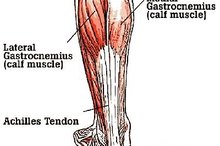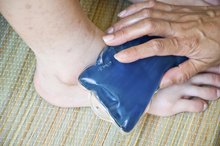Symptoms of Nerve & Tendon Damage in Your Foot
Your feet are two of the most important parts of your body, since they help you get from one point to the next. That’s why when you have an injury, such as nerve damage or a tendon injury, it’s important to get it diagnosed and treated as quickly as possible. Understanding the ins and outs of various foot conditions will help you get back into action without missing a beat.
If you are experiencing serious medical symptoms, seek emergency treatment immediately.
Nerve Damage Symptoms
Numerous types of nerve damage in the feet abound, but most come with the same classic symptoms. Numbness, pain and tingling are some of the more common symptoms associated with nerve damage. You may also feel a pinching inside your foot or weakness in the area surrounding the nerve damage. A swollen nerve may also result in a popping feeling within the foot, according to PodiatryNetwork.com. If the nerve damage is caused by neuroma, or a swelling of a nerve due to injury or trauma, you may be able to relieve some of the symptoms by rubbing or massaging the affected area intermittently until the pain subsides.
- Numerous types of nerve damage in the feet abound, but most come with the same classic symptoms.
- You may also feel a pinching inside your foot or weakness in the area surrounding the nerve damage.
Peroneal Tendon Injury Symptoms
Symptoms of a Torn Achilles Tendon
Learn More
The peroneal tendons attach to your foot at the side of the ankle as well as the inside of the arch of your foot 2. Tendinitis is one of the more common symptoms of injury to these tendons, according to FootHealthFacts.org, and is marked by swelling, tenderness and pain. An actual tear to the peroneal tendons may result in a feeling of weakness or instability in the foot or even a snapping feeling when walking. A degenerative tear—one that occurs over a longer period of time—to one of the peroneal tendons may result in an increase in the arch of your foot.
- The peroneal tendons attach to your foot at the side of the ankle as well as the inside of the arch of your foot 2.
- An actual tear to the peroneal tendons may result in a feeling of weakness or instability in the foot or even a snapping feeling when walking.
Achilles Tendon Tear Symptoms
The Achilles tendon is the main tendon connecting the back of the foot, or the heel, to your leg. One of the main symptoms you may feel upon a full rupture is an actual popping noise or sensation on the back of your heel. This is followed by pain, swelling and an inability to push off with or stand on the toes of your injured foot. You may also be unable to tilt your foot downward when it is elevated due to the damage of the tendon.
- The Achilles tendon is the main tendon connecting the back of the foot, or the heel, to your leg.
- This is followed by pain, swelling and an inability to push off with or stand on the toes of your injured foot.
Related Articles
References
- Foot Health Facts: Peroneal Tendon Injuries
- Mayo Clinic: Achilles Tendon Rupture: Symptoms
- Garrett A, Geiger Z. Anatomy, bony pelvis and lower limb, calf deep peroneal (fibular) nerve. In: StatPearls. Updated December 13, 2018.
- De Maeseneer M, Madani H, Lenchik L, Kalume Brigido M, Shahabpour M, Marcelis S, de Mey J, Scafoglieri A. Normal anatomy and compression areas of nerves of the foot and ankle: US and MR imaging with anatomic correlation. Radiographics. 2015 Sep-Oct;35(5):1469-82. doi:10.1148/rg.2015150028
- National Institute of Neurological Disorders and Stroke. Foot drop information page. Updated March 27, 2019.
- Kitamura T, Kim K, Morimoto D, et al. Dynamic factors involved in common peroneal nerve entrapment neuropathy. Acta Neruochir. 2017 Sep;159(9):1777-1781. doi: 10.1007/s00701-017-3265-2.
- Neuromuscular Disease Center, Washington University. Common peroneal nerve. 2019.
- Ortho Bullets. Deep peroneal nerve. 2016.
- TeachMeAnatomy. The deep fibular nerve. 2018.
- Bito T, Tashiro Y, Suzuki Y, et al. Forefoot transverse arch height asymmetry is associated with foot injuries in athletes participating in college track events. J Phys Ther Sci. 2018;30(8):978–983. doi:10.1589/jpts.30.978
- Freedman BR, Gordon JA, Soslowsky LJ. The Achilles tendon: fundamental properties and mechanisms governing healing. Muscles Ligaments Tendons J. 2014;4(2):245–255. Published 2014 Jul 14. PMID: 25332943
- Tips to Keep Feet Warm and Cozy All Winter Long. Winter Foot Care. American Podiatric Association
- Park SY, Bang HS, Park DJ. Potential for foot dysfunction and plantar fasciitis according to the shape of the foot arch in young adults. J Exerc Rehabil. 2018;14(3):497–502. Published 2018 Jun 30. doi:10.12965/jer.1836172.086
- Petraglia F, Ramazzina I, Costantino C. Plantar fasciitis in athletes: diagnostic and treatment strategies. A systematic review. Muscles Ligaments Tendons J. 2017;7(1):107–118. Published 2017 May 10. doi:10.11138/mltj/2017.7.1.107
- Pita-Fernandez S, Gonzalez-Martin C, Alonso-Tajes F, et al. Flat Foot in a Random Population and its Impact on Quality of Life and Functionality. J Clin Diagn Res. 2017;11(4):LC22–LC27. doi:10.7860/JCDR/2017/24362.9697
- American Academy of Orthopaedic Surgeons. Posterior Tibial Tendon Dysfunction. Sept 2017.
- Arthritis Foundation. Anatomy of the Foot.
- Mayo Clinic. Hammertoe and Mallet Toe. July 28, 2917.
Writer Bio
James Patterson specializes in health and wellness topics, having written and produced material for the National Institutes of Health, the President's Cancer Panel and an Inc. 500 Hall of Fame company. He is also a former sportswriter with writing experience in basketball, baseball, softball, golf and other popular sports.








